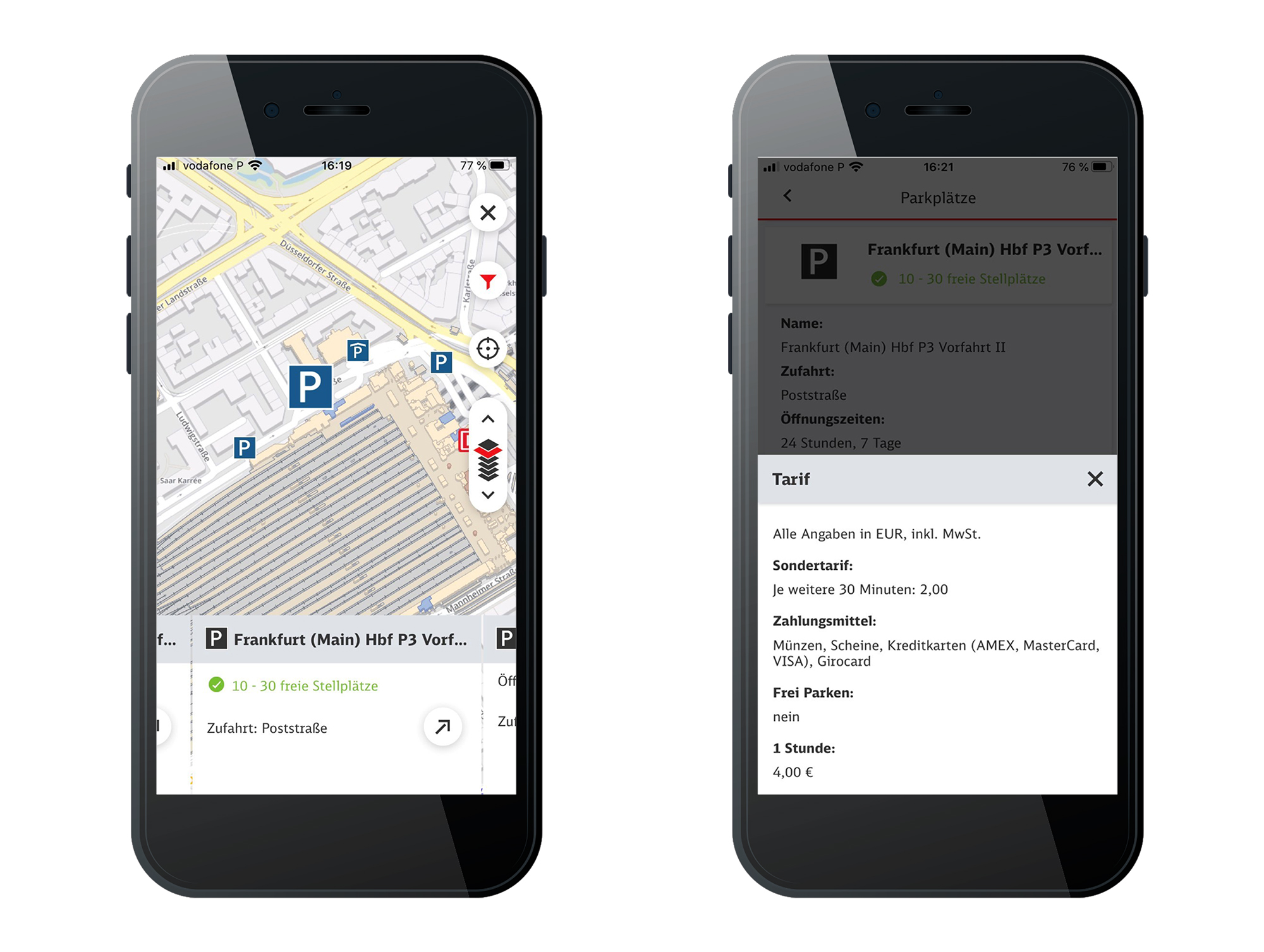Car parking at railway stations
Article: On track to ensure a seamless travel chain
08/2020 – Rail customers will be able to learn about the parking facilities available at their departure and destination stations prior to commencing their journey. This level of convenience can be achieved in apps and on websites thanks to a service that uses a standardised interface (API) to make information on car parking at railways stations available for every application within the DB Group.
Train journeys often involve not only the train ride itself but also the initial car journey to the station, for example. For this reason, customers want an answer to the all-important question of what on-site parking facilities are available and, specifically, the number of vacant parking spaces. The website ParkenAmBahnhof (German only) can provide a quick response. To obtain a forecast involving over 300,000 parking spaces at over 5,000 stations, simply enter the destination station and the radius in kilometres. Underpinning this forecast is a service that makes this data available in real time. “Nowadays, the first/last mile issue is very important to ensure a seamless journey for our customers,” explains Marcel Pinnow, software development engineer at DB Systel as well as product owner and IT manager for this project.
What does “first / last mile” mean?
In many areas of our economy, we come across first and last miles, for instance when talking about utilities (electricity, gas or telecommunications), in air freight, the postal service or logistics. In the context of mobility, the term can be explained as follows:
In addition to the main leg of a journey by train, the first or last mile plays an important role in the end-to-end process of passenger or freight transport. The term refers to the route from the point of departure of the journey or transport (e.g. home address, warehouse) to where the transport service starts (e.g. the railway station). This is the first mile. And it refers to the route from where the service is completed (e.g. at the railway station) to the actual travel or transport destination (e.g. delivery address, holiday destination), the last mile.
Customers still often use a hire car, or their own car, to drive to the railway station and therefore need a parking space nearby.
"We had received enquiries from DB Connect about car sharing and from DB Station&Service AG about car parking. These enquiries then sparked the idea by DB BahnPark and DB Systel to create a joint API service for car parking at railway stations, which would provide customers with the fastest way to switch to public transport."
Forecasts for vacant parking spaces attract great interest
DB BahnPark, a joint venture of DB Station & Service AG and Contipark, a car park provider operating in Europe, provides a powerful database of parking information for use with this service. “The mode of transport often changes at railway stations. DB BahnPark wishes to make it possible for customers to use eco-friendly rail travel as an alternative form of travel. By doing so, we are, in effect, helping customers not to use their cars,” explains Dieter Siebert, Head of Marketing at DB BahnPark. This database will be expanded in the future to serve further use cases. “The challenge here is that all of this data must work in unison.”


The first step in the partnership between DB BahnPark and DB Systel was to use this data to predict the availability of parking spaces. Live data is available in over forty of DB BahnPark’s parking facilities and can be used to forecast vacant parking spaces at a certain time on a certain day. “This enables you to predict, with a high degree of probability, whether a vacant parking space will be available,” explains Pinnow. “One major advantage of using data to resolve this issue is the cost savings. It is much cheaper to use digital technology to answer questions regarding availability than to use much more expensive on-site systems in the car parks themselves”. Market interest in forecast data is correspondingly high. “parkenambahnhof.de is merely a digital continuation of what we have already been doing operationally for the past ten years. In the future, the data must bridge the gap of you, for example, telling routing systems the location of vacant parking spaces at railway stations, how much they cost and whether they are vacant,” explains Siebert.
Making data available to the market
This data is available to the DB Group via the DB API Portal, Deutsche Bahn’s internal marketplace for developers, and is very easy to use thanks to a REST API (application programming interface). From the very outset, the team gave considerable thought to making it easy to reuse data in different applications, irrespective of whether this data was required for the website or apps. Agile project methods also accelerated the development process, which quickly led the team to an outcome that was of far-reaching benefit. “Rather than creating a ‘monolith’ for a single project or customer, reusability enables us to create a solution that can be easily integrated into many applications,” explains Tamara Wagner, Business Consultant at DB Systel, in charge of strategy for this project.
The data rapidly spreads to other applications. Already, parking space data is not only available on the website, but it also supplies the mobile app “DB Bahnhof Live” with information about car parking at railway stations. “Customers who want convenience upon arrival can use this information to plan ahead. Digitalisation, however, allows customers to go even further by reserving and paying for a parking space in advance,” says Wagner. The “DB Bahnhof Live” app is the first such step here. Preparations are also under way to facilitate further data usage via the REST API, for example, for products such as Park and Rail.
"An example of another good service would be if customers could use the app to buy a single ticket that covers both the train journey and the parking space. We’re not quite there yet, but the concept of this service is already in the pipeline and is undergoing technical inspection."
In the future, this service will be supplemented by external data sources to cover available parking spaces on the roads near railway stations. “Ultimately, customers only care about whether or not they get the parking space they need. We can already predict this for some parking facilities. In the future, however, this should be possible for all parking facilities. At present, it is still difficult to obtain sufficiently high-quality movement data from car parks and their surrounding areas. We collect the data ourselves. We are also in talks with other car park providers and data providers across Europe,” explains Siebert.
One ticket for all your needs
The long-term plan is to also use the API to make this data available to our external partners via developer marketplaces. Looking ahead, many more use cases involving parking data are conceivable with digitalisation. For example, apps could display the fastest route to a car park. Thanks to the modular principle of APIs, these services can also be combined with other useful data, such as weather reports. However, the goal of all digital services remains the same, namely to make the customer’s journey as seamless, comfortable and convenient as possible. “We aim to provide customers with just one ticket for the entire journey, including cross-border transport and public or alternative modes of transport, and to do so on a DB app without any discontinuity of media,” explains Wagner. “The perfect scenario would be one where customers could book not only their car park ticket but also a ticket for local public transport or a hire car at their destination. This is already on our agenda. All in all, it will be a major integration process,” says Siebert, looking ahead to the future.



